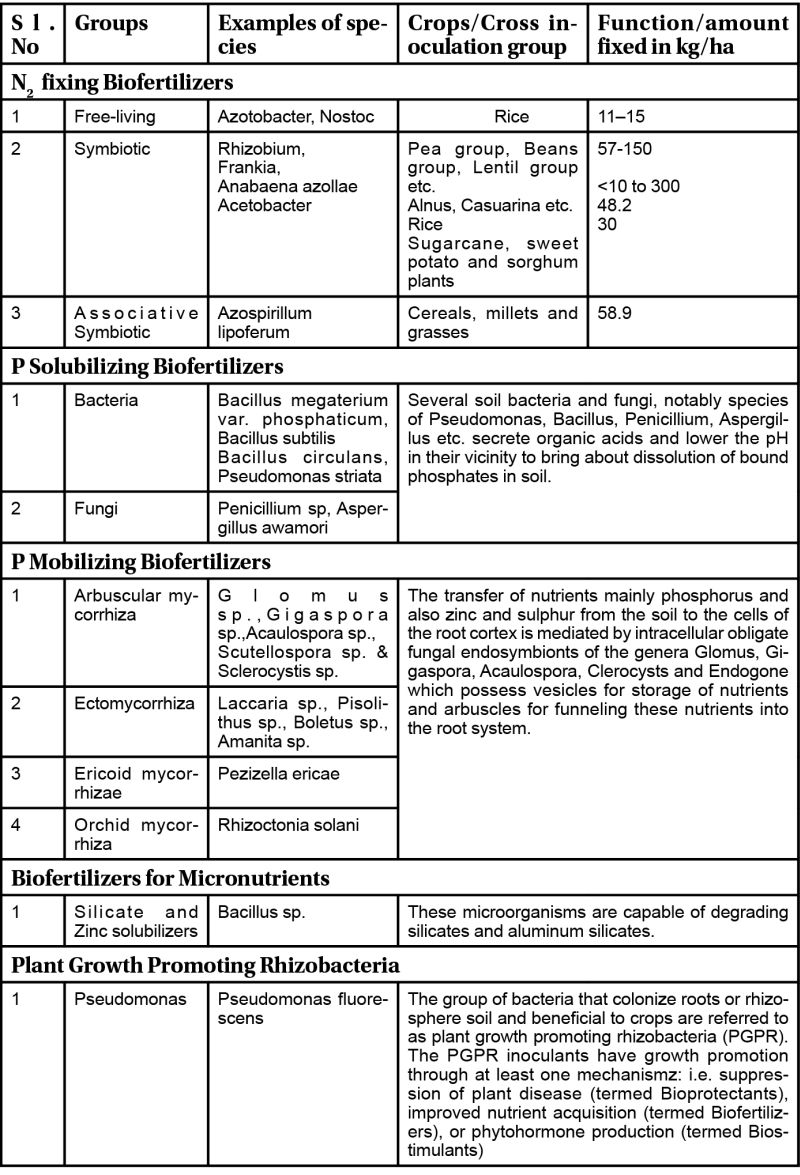
Biofertilizers are carrier based inoculants containing beneficial, efficient and effective microorganisms which help in enhancing the soil fertility either by fixing atmospheric nitrogen, solubilization/mineralization of phosphorus and potassium or decomposing organic wastes or by producing plant growth substances. Biofertilizers are more commonly known as microbial inoculants which are artificially multiplied cultures of certain soil organisms that can improve soil fertility and crop productivity. Microorganisms present in them are helpful in increasing the supply of nutrients, mobilized them and make them easily available to the plants and increase the grain yield. Biofertilizers are gaining momentum recently due to increasing emphasis on maintenance of soil health by cutting down the use of chemicals in agriculture. It is also low cost which can even supplement the chemical fertilizers.
Types of Biofertilizers: Biofertilizers can be grouped in different ways based on their nature and function and they are given in the following table.

Different forms of Biofertilizers used
1. Solid Biofertilizers: Some biofertilizers are available in the solid form as the carrier material used is solid materials. Shelf lives of solid biofertilizers are usually for 6 months.
2. Liquid Biofertilizers: Biofertilizers, such as Rhizobium, Azospirillum and Phosphobacteria provide nitrogen and phosphorous nutrients to crop plants through nitrogen fixation and phosphorous solubilization processes. These Biofertilizers could be effectively utilized for rice, pulses, millets, cotton, sugarcane, vegetable and other horticulture crops. These biofertilizers are available in liquid form and the shelf live is more than the solid biofertilizers i.e. 1 year.
3. Mixed biofertilizers: Mixed biofertilizers (BIOMIX) containing a consortium of N fixers, P solubilisers and PGPR found to promote the growth of cereals, legumes and oilseeds better and save 25% NP fertilizers in crops.
Earlier, products of bio-fertilizers were solid carrier based where lignite normally used which is hazardous to the production workers plus shelf life is only 6 months and is difficult to transport. But recently the liquid based biofertilizers (LBF) are gaining momentum due to their longer shelf live and with no health hazards to production workers. Additionally, LBF can be used in drip irrigation and as a component of organic farming.
Application and use: Biofertilizer can be applied in different ways:
Seed treatment
Seedling dipping
Soil application
Depending on the biofertilizer, and the crop grown, different methods of application are adopted. In general, the performance of biofertilizers is more when used along with organic manures like compost. In rainfed farming, since moisture is limiting, best performance from biofertilizers can be realized when moisture conservation practices are adopted along with application of biofertilizers. Treatment of seeds with the slurry of inoculant is the most effective method of application. For this prepare the slurry of required quantity of inoculant in sufficient water (generally 400-500 ml of water for 200 g inoculant) as given below:
• Boil 50 g gur in one litre of water and cool it
• Pour this slurry over the heap of seeds to be treated
• Mix the seeds thoroughly with hands
• Spread the treated seeds over clean floor or on plastic sheet or on gunny bag and dry under shade.
• Sow the treated seeds as early as possible
10 kg of normal size seeds such as moong, urd, arhar, cowpea, lentil and berseem may be treated with 200 g of Rhizobium inoculant by slurry method. Large size seeds such as groundnut, chickpea, soybean and pea, etc., require 400 to 500 g of inoculant for 10 to 12 kg of seeds.
• Root dipping is mainly used for application of Azospirillum/ PSM on paddy transplating/ vegetable crops. Required quantity of Azospirillum/ PSM has to be mixed with 5-10 litres of water at one corner of the field and the roots of seedlings has to be dipped for a minimum of half-an-hour before transplantation.
• For soil application 200ml of PSM per acre is used. Mix PSM with 400 to 600 kgs of cow dung FYM along with ½ bag of rock phosphate if available. Mixture of PSM, cow dung and rock phosphate have to be kept under any tree or under shade for overnight and maintain 50% moisture. Use the mixture as soil application in rows or during leveling of soil.
Conclusion: An alternative strategy to ensure yield and protection of crop is the need of the hour looking into the health and environmental consequences of increasing amounts of fertilizers. Possible alternative to chemical fertilizers can be use of efficient microbial inoculants for biofertilizer in agriculture which is environmentally safe and sound. This approach can give the sustainable agriculture as it does not deteriorate the soil. Based on living micro-organisms these inputs can make nutrients abundantly available in atmosphere and soil accessible for plant use without the adverse impact that chemical fertilizers have on soil, water and air.
Article contributed by Christy BK Sangma, Rokozeno Chalie-u, Imtisenla Walling and LK Baishya, ICAR Research Nagaland Centre, Medziphema



